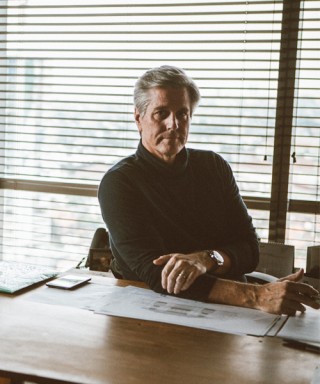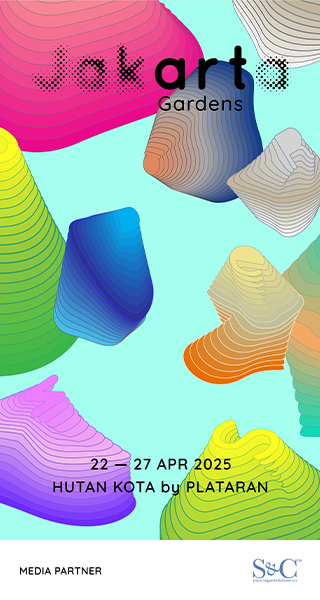
The Wings of Nus Salomo : ‘WING THINGS”
Published by Sugar & Cream, Monday 20 May 2019
Curatorial text by Rizki A. Zaelani, images courtesy of Nus Salomo
Galery Nasional Indonesia : May 20 – June 12, 2019
Making beautiful things for everyday use is a wonderful thing to do…
making life flows more easily…
but art confronts life, allowing it to stop and perhaps change direction…
they are completely different – ANTHONY GORMLEY
Imagination is the one weapon in war against reality -JULES DE GAULTIER
As an artist, Nus Salomo’s career trajectory is rather unique. He was initially trained in architecture, in Bandung, before going to the United States to study animation and digital visual technology. There, Nus was exposed to, and worked directly with, the latest technological developments in the global cinema industry that is increasingly dependent upon digital technology. This experience and his personal journey not only helped to provide a foundation for his creative processes later on, they also allow him to get a sense of the fertile ground that forms the foundation of contemporary society. Life today, in the era of digital and technological advancement is unlike how it was lived back in the times when everything—an object or a thing, a circumstance, a movement, etc – was perceived in an analog and manual way. Improvements in digital technology does not only bequeath the techniques and methods to engineer reality in a quicker and easier way, but further, it introduces a version of reality that is not fully clear, even drawing an increasingly uncertain connection between people and reality itself. The historically important function of the human vision is slowly being replaced by various practices and techniques whereby a visual image no longer retains a clear or direct optical connection with the ‘real’ position of the observer (Crary 1996:17). These days, we can ‘see anything (from) anywhere’ without needing to shift or change the positions of our physical self while we ‘gaze’ or ‘look’. Culture is sensed and understood virtually, and not only does it allow people to more easily look at anything, anywhere, anytime, it also allows them the opportunity to recognize (anew) whatever it is they wish to look at.
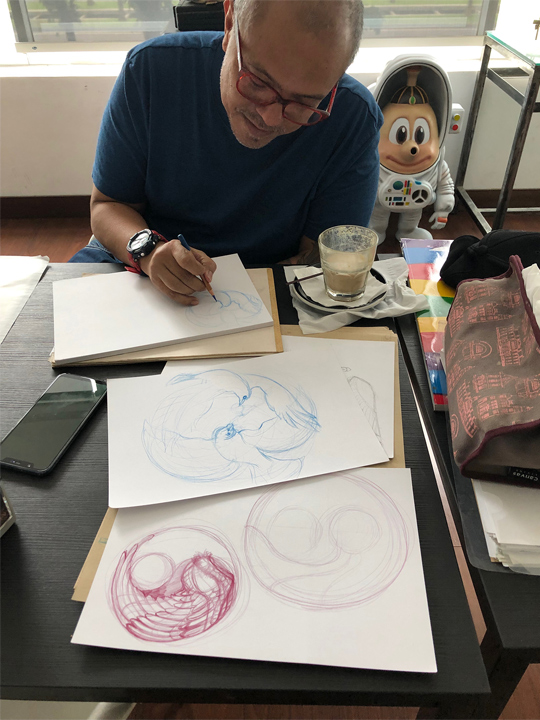
For many people, the advancement of ‘the way we look at things’ through digital and virtual reality is seen as a captivating landscape of possibilities that allows everything to be seen and enjoyed as extensively as possible. But for another smaller set of people, these advancements also reveal a depth of mystery that grows more difficult to recognize. The works of Nus Salomo often describe unusual life situations, sometimes odd and fantastical, as though describing circumstances that hang between ‘here’ and ‘there’, between ‘the now’ and ‘that which is yet to come’ or those ‘that had come to pass’. His works tend to imply fantasies, which in their turn invite questions such as: where are we? Researcher Mary Anne Staniszewski explained that a civilization/tradition’s strongest and clearest “truth” can be found in the things that cannot be described or stated directly. In the modern era, stories about “truths” such as this often relates to art (Staniszewski, 1995:1). Everything that we know about ourselves do not occur naturally, because they are actually ‘formed’ through a series of spatial and temporal introductions. Everything that we see, sense, touch, think, remember, create, even dream about, cannot be separated from the way we culturally recognize symbols and languages—art expression is part of this.
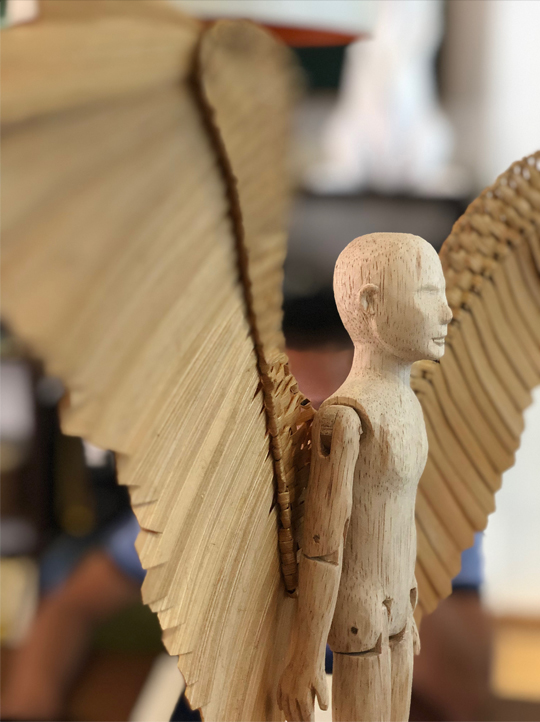
As a symbol or language, art even lays claim to a level of preeminence or distinction because it is through art expression that we can begin to understand and recognize how a means of representation can lead to meaning as well as power. Nus Salomo has chosen to embark on his ‘wings project’ as a way to discover and make a statement about the kind of ‘language’ that may represent the human condition today; he has chosen to show the possibility of a person ‘taking flight’ and how such a person may be able to consider his/her problems from a bird’s eye’s view. To Nus, this choice is not just an invitation to examine ‘how people may live their lives’ but also to look at ‘ways to alter/change their lives’ if necessary. Nus’s choice reminds me of a statement by the sculptor Anthony Gormley: “Making beautiful things for everyday use is a wonderful thing to do… [It makes] life flows more easily… but art confronts life, allowing it to stop and perhaps change direction… Creating artworks and [making] beautiful things are completely different.” It is however not Nus’s intention to sharply delineate between what ‘must’ be considered art and what we can consider to be objects of beauty. It seems that he has another plan to connect the two, which is as mysterious as a person’s own wish to understand his/her own self.

Presented by Interni Cipta Selaras
Wings, Visions, and Imaginations
Nus received a particularly meaningful experience from working with his ‘wings‘. The concept of ‘wings’ has always interested him, has always appealed to his creative intentions, especially when he wishes to make statements on the importance of progressing a vision and one’s own understanding in order to navigate life in an ever-evolving civilization. It so went that Nus Salomo successfully received the opportunity and appointment to work on a large-scale public sculpture, to be placed at a prestigious location—he had to go through a series of processes to get to this stage, from selection to concept consultations, etc, and each step demanded a lot in terms of time, energy, even financially. Nus’s wings concept was but one out of the many concepts to have been considered. Unfortunately, in the end, and despite all the work and sacrifices to complete the work, Nus had to resign himself to the fact that the already-mounted work had to be dismantled and taken down. It was not to be displayed in public, he was told, for the ‘good of the public’. Nus was certainly upset and disappointed, but he decided not to protest the one-sided decision.
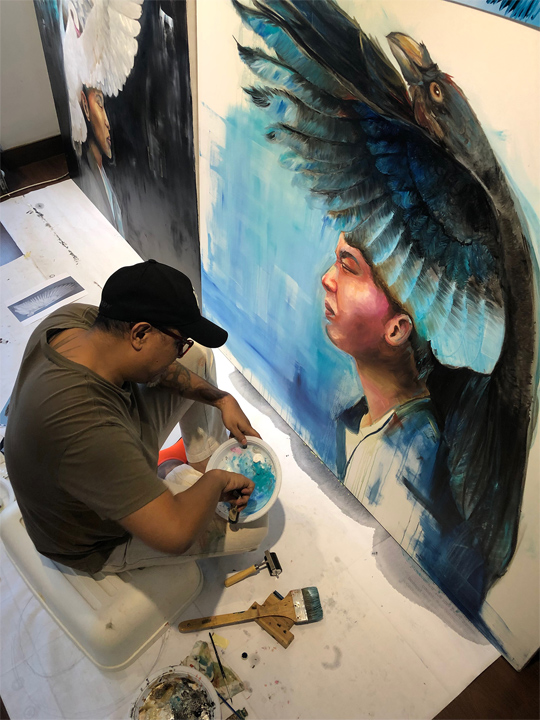
This occasion left a deep impression in Nus Salomo. He became more convinced of the importance of having a vision within a person’s personal progressions. People cannot merely depend on the opportunities, status, functions, or authority that have been socially afforded to them; rather, that person must also kindle their individual visions so they can elevate everything else that exists outside of themselves, socially or culturally. Modern society certainly has a way to apportion life systems, to box up different interests, affairs, even life events through a system of administration and bureaucracy that are mostly meant to regulate and guarantee the continued turning of the social wheel. Often, these systems are effective enough to regulate, even ‘control’ the people that run them, or if we may put it more precisely, these very systems may even lull people into a sense of comfort so much so that they no longer have the desire to develop upon their ‘real’ life visions. It is not rare to see how these systems tend to forcefully separate the so-called achievements that support a well-regulated social life from cultural interests. Perhaps, Nus Salomo’s public sculpture—which did not end up becoming public property—was one of those affected by a system that has gotten used to running itself and which has perhaps become distanced from the interests of the people who drew it up in the first place.
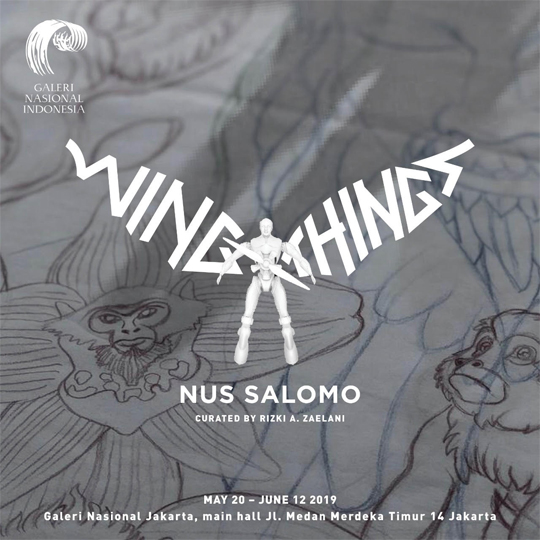
Life dramas that surround Nus Salomo’s wing sculpture has led him to two clear conclusions. Firstly, ‘wings’ as theme or concept has become so deeply rooted that it continues to inspire him to create. Secondly, Nus has become even more certain that ‘wings’ are the most apt metaphor in trying to understand and negotiate one’s way through the myriad problems that exist in contemporary reality and society. Researcher Terry Eagleton once expounded how culture has become so strongly interconnected with social dimensions in today’s contemporary society (unlike how it was in the Modern Era, with its strong administrative and bureaucratic systems). Examples of the reintegration of cultural and social lives, today, can be seen in the way common commodities have become more aesthetic, in the various instances that have turned the political arena into something akin to entertainment or spectacle, in consumerist lifestyles, in the increasing importance placed on image (either as visual image or as self-image), and in A final integration of a cultural condition that we must now understand as part of commodity production (Eagleton, 2000:30). Nus feels that ‘wings’ may serve as an apt metaphor that can help us understand and overcome (if need be) today’s life realities. These days we not only need a vision of progress in order to live, but also the skills and abilities that can fuel the imagination itself. Vision and imagination, for Nus Salomo, is as though a pair of wings that can carry us to a higher realm. This is perhaps reminiscent of a statement made by early 20th century French philosopher Jules de Gaultier: “Imagination is the one weapon in the war against reality.”
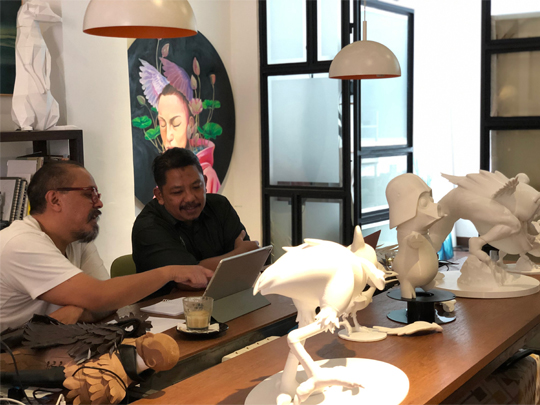
Thus we can say that imagination is a person’s life force. To cultural theoretician Raymond Williams, imagination is a “mental conception, including a quite early sense of seeing what does not exist as well as what is not plainly visible” (William, 1988:158). Nus Salomo realized that his previous experience in the digital industry can be likened to a keyhole whose key he eventually gained through the drama of his aborted public sculpture. Nus is even more convinced that imagination is a force that can direct and motivate a person’s personal progress. Nus no longer wants to rest fully upon reality. Rather he wishes to participate more actively in the creation of said reality. The strength of imagination and the force of his visions are wings that can help him fly. He is not fantasizing. Rather, he wishes to discover knowledge about life as best he could. Imagination is the only path toward knowledge and understanding, while also a path leading to illusion and the idealization of reality pursued by knowledge itself (Kleden, 1998:32).
Wing things: The Wings of Nus Salomo
Works shown at this exhibition are, in the whole, results of Nus Salomo working on ‘wings’ as his concept—also including the wing-formed he had worked on for his (aborted) public sculpture. The idea of ‘wings’ seems to also suggest, or attempt to explain, how a person requires some method by which he can view life’s realities as a bigger picture or from a ‘distance’; or to explain about the desire to free human existence from the trap of false certainties as promised by our daily realities. In fact, cultural life can never be completely regulated or measured by some social administration system. Though far from describing culture as a complete and exact value, theoretician Raymond Williams have for a long time reminded us that we will never be able to fully make ‘culture’ into a manifestation of exact and fixed science. “A culture,” he stated, “while it is being lived, is always in part unknown, in part unrealised. The making of a community is always an exploration, for consciousness cannot precede, and there is no formula for unknown experience,” (Williams, 1963:334). Perhaps, in the same way as Anthony Gormley, Nus understands art expression as a medium and an intercessor between humankind and a person’s efforts to live life, to recognize and understand uncertainties, to realize that not-knowing is also part of our greater knowledge about life.
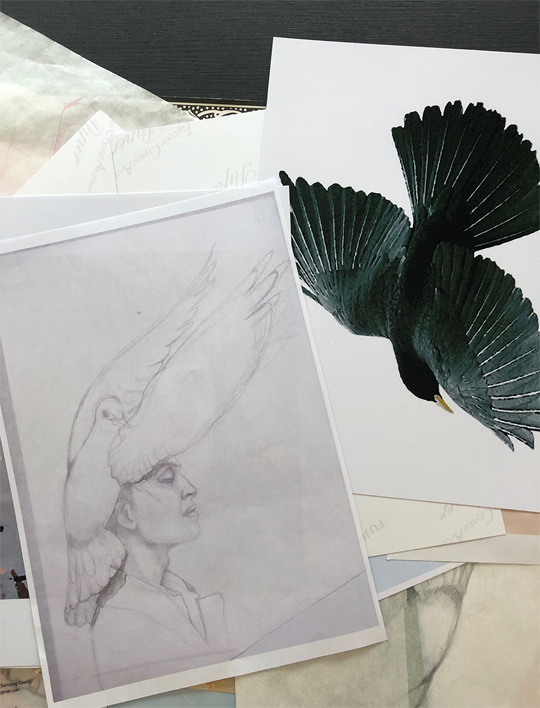
I call Nus Salomo’s project wing things, things concerned or related to wings, to elaborate upon how Nus discharges himself and chooses the method of his art creation. As though drawing a long connecting line through diverse artistic methods and means, Nus tries to connect two main ideas that are usually distanced from one another—the ideal and the artificial; the personal and the social; the manual (analog) and the digital; manual work and mechanical work. For this exhibition, Nus has created drawings, paintings, photographs, video artworks, sculptures, objects, and installation pieces. They are exhibited as one amalgamation of various manifestations that emerge from one, same idea source: things about wings. Nus never imagines working with only a single and predetermined method of creation. Furthermore, it seems that Nus has even taken away the thing that separates design work from art creation, even so far as to come across as trying to intertwine many different methods of creation, crossing genres between fine art, design, craft, and architecture. As a sculptor, Nus Salomo no longer recognizes ‘monument’ and ‘monumental work’ as proof of memory’s achievement over an idea to be presented as a monoformic centralized statement or as a reference to be applied to many circumstances. To Nus Salomo, “monumental experience” is found in the success of recognizing and discovering a vision of one’s own progress, springing forth from within one’s own self. He does not see the need to create something ‘big’ or something to be referenced by other people. The successful manifestation of a person’s imagination and vision, at the very least, will have helped that person, and perhaps others outside of that person, to discover their own selves so they can together manifest the true meaning of progress. Art expression, in practice, introduces a person to monumental life experiences, starting from the landscapes within himself as the most important element.
To me, the wing things project is not only personally and culturally meaningful to Nus Salomo, but that it also suggests directions and lessons. Nus‘s experience is perhaps but one out of the many differently-manifested yet similar stories relating the following caveat: that a person does not always achieve what they strive toward. Reality may sometimes seem to plot against a person in the middle of working on it or appreciating it, by throwing that person onto a different trajectory from the one first intended. Everyone needs an experience that can help them progress in a balanced way, so that he can one day stand firm and decide his own trajectory. Someone who is able to fly on his wings of vision and imagination will certainly gain more opportunities to recognize and experience a balanced progress. Vision without imagination is like flying with only one wing; while imagination without vision only leads a person to the valley of illusion and useless idealisms.
 1.05K
03/07/2025
1.05K
03/07/2025
DARE TO LISTEN! JBL FESTIVAL SIAP MENGGUNCANG JAKARTA – 13 SEPTEMBER 2025
Dare to Listen! JBL Festival Siap Mengguncang Jakarta pada tanggal 13 September 2025 dengan kehadiran musisi papan atas: Slank, Ari Lasso, Tiara Andini,...
read more 826
03/07/2025
826
03/07/2025
CIERRE1972 (2025 COLLECTION) - COLLECTION25: PART 1
The 2025 Collection by Cierre1972, which was on display at Salone del Mobile 2025, combined Italian craftsmanship with a global appeal through its bold...
read more 12.09K
17/06/2025
12.09K
17/06/2025
JAIPUR RUGS X PETER D’ASCOLI PRESENTS THE GILDED AGE COLLECTION (2025)
The Gilded Age collection by Jaipur Rugs X Peter D’Ascoli channels the decadent glamour of 19th-century design into bold, hand-knotted rugs that exude...
read more 10.83K
12/06/2025
10.83K
12/06/2025
MOLTENI&C 2025 COLLECTION – THE COLLECTION BY YABU PUSHELBERG, GAMFRATESI, UNIFOR X LSM
MOLTENI&C 2025 COLLECTION – THE COLLECTION BY Yabu Pushelberg, GamFratesi, UniFor x LSM
read more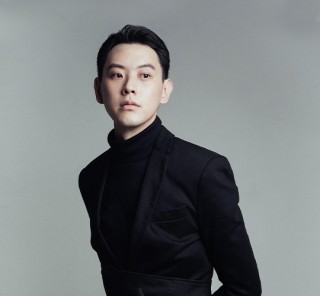 74.62K
10/01/2025
74.62K
10/01/2025
W RESIDENCE IN SOUTH JAKARTA BY MICHAEL CHANDRA
Michael Chandra, founder of MNCO Studio Design has created the W Residence with an aesthetically pleasing, practical, and pleasant home from all...
read more 33.43K
16/05/2017
33.43K
16/05/2017
A Spellbinding Dwelling
Rumah milik desainer fashion Sally Koeswanto, The Dharmawangsa kreasi dari Alex Bayusaputro meraih penghargaan prestisius Silver A’ Design Award 2017.
read more



